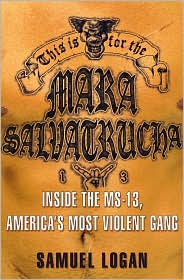“This is For the Mara Salvatrucha”
Samuel Logan, security specialist, author and sometime ZP commenter has a new book that will be released in early July, This Is for the Mara Salvatrucha: Inside the MS-13, America’s Most Violent Gang.
Sam sent me an advance copy and I have read the first few chapters, which begins at the most granular level of an outlier cell or street crew of MS-13 and a crime committed that ultimately allows law enforcement to penetrate what had been a highly secretive, as well as extremely violent, transnational street gang rooted in Central American immigrant communities.
crew of MS-13 and a crime committed that ultimately allows law enforcement to penetrate what had been a highly secretive, as well as extremely violent, transnational street gang rooted in Central American immigrant communities.
The book is tightly written with an edge for gritty reality and will be of great interest to readers interested in criminal networks and insurgency; I will be looking to see how, from Logan’s depiction, MS-13 meshes with John Sullivan and Robert J. Bunker’s concept of 3rd Generation gangs.




June 25th, 2009 at 4:23 am
If the separatist movement ever starts to intensify in the Southwest, I would look for MS-13 and the Mexican Mafia to work with groups like La Raza in a way similar to how Hezbollah operates. La Raza would be the political organization and the "good face," while the MM and MS-13 conduct assassinations, kidnappings, and channels money via the drug trade.
June 25th, 2009 at 4:38 am
Not sure how either group feels toward LaRaza. MS-13 are Central Americans or of that descent – while MS-13 is affiliated with the MM, in my experience the average Guatemalan or Salvadoran has as much love for Mexicans as Egyptians have for Israelis. Passing through Mexico or falling in to the hands of the Federales is no picnic for them. Maybe Sam will appear here and weigh in on that.
June 25th, 2009 at 11:09 am
Off topic question, I though Zen might be able to help me with? Can you recommend any books about the US Army and settling of the American West?
June 25th, 2009 at 2:45 pm
Seerov, these are from my book list, and may be what you are looking for.
Edward M. Coffman The Old Army: A Portrait of the American Army in Peacetime, 1784-1898 (1986) Odie B. Faulk The Geronimo Campaign (1993) John S. Gray Centennial Campaign: The Sioux War of 1876
(1976) Jerome A. Greene Yellowstone Command: Colonel Nelson A. Miles and the Great Sioux War, 1876-1877 Paul Andrew Hutton Phil Sheridan and His Army (1985) [Post-Civil War] R. Douglas Hurt The Indian Frontier, 1763–1846 Peter Karsten, ed. The Military in America From Colonial Times to the Present (Rev. Ed. 1986) Francis P. Prucha The Sword of the Republic: The United States Army on the Frontier, 1783-1846 Donald Rickey Forty Miles a Day on Beans and Hay (1963) [the frontier army, 1865-1890] Michael L. Tate The Frontier Army in the Settlement of the West (1999) Robert M. Utley, Wilcomb M. Washburn The Indian Wars Robert M. Utley Frontiersmen in Blue: The United States Army and the Indian, 1848-1865 Robert M. Utley Frontier Regulars: The United States Army and the Indian, 1866-1891 (1974) Bill Yenne Indian Wars: The Campaign For The American West (2006)
June 26th, 2009 at 4:05 am
Thank you LG.
June 26th, 2009 at 12:24 pm
It’s possible that MM and La Raza already have ties. Overlap is cultural and perhaps even within extended familial networks – third cousins, for example, are often well known in Latino culture.
A direct interaction between the MS-13 and La Raza, however, is unlikely. I can see how the MS-13 would act on behalf of La Raza, but with the order coming from MM. It’s also likely that the MS-13 would take orders from the Carrillo-Fuentes organization in Juarez, the Beltran-Leyva brothers organization, the Sinaloa Cartel, or the Arellano-Felix Cartel. They probably don’t work with the Zetas, as one top Zeta, Miguel Triveño has been attributed to having said:
"The MS-13 is like a rabid dog. You let it off the leash and there’s no telling who it’s going to attack."
Happy to contribute! And thanks for the post.
Sam Logan
http://www.thisisforthemarasalvatrucha.com
July 2nd, 2009 at 2:58 pm
Nice. Would like to read this myself.